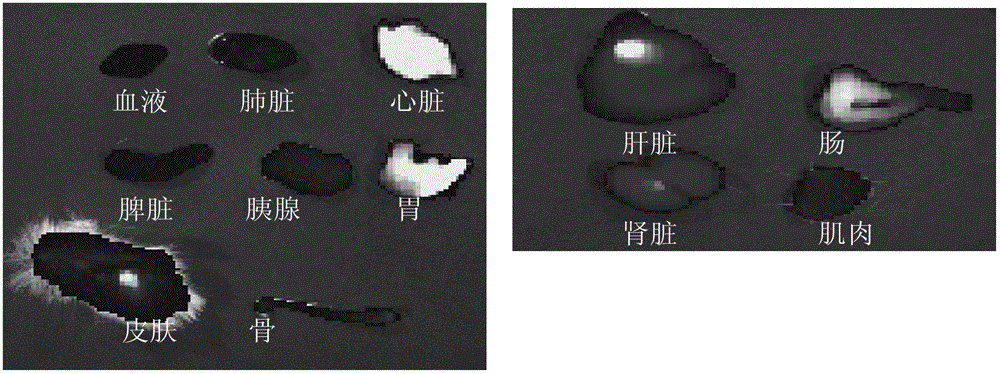Targeting molecular imaging probe and living molecular imaging method
一种分子探针、分子成像的技术,应用在医用领域,能够解决不易获得药代动力学特征和生物学分布特征、随机性大、操作复杂等问题,达到良好药代动力学特征和生物学分布特征、图像的对比度佳、检测结果准确的效果
- Summary
- Abstract
- Description
- Claims
- Application Information
AI Technical Summary
Problems solved by technology
Method used
Image
Examples
Embodiment 1
[0092] Example 1: Cx43 targeting affinity component--Cx43 targeting binding peptide (Cx43SP)
[0093] Any of the following 4 types of polypeptides (Cx43 targeting binding peptides) can specifically bind to the carboxy terminus of Cx43, and therefore can be used to synthesize Cx43 targeting molecular probes.
[0094] 1), the structure of Cx43SP1:
[0095] Gly-Ala-Pro-Gly-4Hyp-Pro-Tyr, also known as: AAP10, molecular formula: C 26 h 37 N 7 o 8 , molecular weight: 575.6, its structure is as follows:
[0096]
[0097] Cx43SP1 is the most important targeting affinity component in the molecular probe of the present invention, and is a polypeptide composed of 6 amino acids that can specifically recognize Cx43 in vivo and bind to it. Cx43SP1 is a series of antiarrhythmic polypeptides that were extracted from bovine atrial tissue by Aonuma S et al. in 1980 and acted on Cx43, so it was once named antiarrhythmic peptide10 (AAP10). However, due to the unstable structure of AAP10 ...
Embodiment 2
[0109] Embodiment 2: Preparation of Cx43 targeting molecular probe
[0110] The general structural formula of the Cx43 targeting molecular probe of the present invention is as follows figure 1 shown.
[0111] (1) The imaging target is connexin 43 (Connexin 43, Cx43). The carboxy-terminal (C-terminal) of Cx43 has a gated granular structure, which functions as a specific receptor domain and is the main binding of Cx43SP The target is the target of Cx43 targeted imaging in the present invention.
[0112] (2) Signal component: It is the part of the probe that can be detected by imaging equipment. In this patent, it mainly includes radioisotopes (PET and SPECT imaging), fluorescent dyes and quantum dots (optical imaging), paramagnetic materials and superparamagnetic materials. Materials and magnetic nanoparticles (magnetic resonance imaging), ultrasonic microbubbles (ultrasound imaging), various photoacoustic nanoparticles (photoacoustic imaging) and the combination of the above...
Embodiment 3
[0115] Example 3: Preparation of radioactive isotope-labeled Cx43 targeting molecular probes
[0116] The four types of polypeptides in Example 1 can all specifically bind to the carboxy terminus of Cx43, and therefore can be prepared as labeled Cx43 targeting molecular probes. In the following synthesis process examples, Cx43SP1 is used as a representative polypeptide.
[0117] The signal components are positron-emitting radioisotopes or single-photon radionuclides, which can be used in clinical and small animal positron emission tomography (PET) or single photon emission tomography (SPECT). By choosing the appropriate linker, the radioactive isotope and the targeting peptide can be linked together by radiochemical methods. The linker employed is also called a bifunctional chelator. The bifunctional chelating agent not only has a functional pattern group that binds to radioactive metals, but also has a group that binds to Cx43SP, and connects the two to become a Cx43 target...
PUM
 Login to View More
Login to View More Abstract
Description
Claims
Application Information
 Login to View More
Login to View More - R&D
- Intellectual Property
- Life Sciences
- Materials
- Tech Scout
- Unparalleled Data Quality
- Higher Quality Content
- 60% Fewer Hallucinations
Browse by: Latest US Patents, China's latest patents, Technical Efficacy Thesaurus, Application Domain, Technology Topic, Popular Technical Reports.
© 2025 PatSnap. All rights reserved.Legal|Privacy policy|Modern Slavery Act Transparency Statement|Sitemap|About US| Contact US: help@patsnap.com



